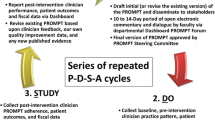Abstract
To assess the relationship between the addition of advanced monitoring variables and changes in clinical decision-making. A 15-questions survey was anonymously emailed to international experts and physician members of five anesthesia societies which focused on assessing treatment decisions of clinicians during three realistic clinical scenarios measured at two distinct time points. The first is when typical case information and basic monitoring (T1) were provided, and then once again after the addition of advanced monitoring variables (T2). We hypothesized that the addition of advanced variables would increase the incidence of an optimal therapeutic decision (a priori defined as the answer with the highest percentage of expert agreement) and decrease the variability among the physician’s suggested treatments. The survey was completed by 18 experts and 839 physicians. Overall, adding advanced monitoring did not significantly increase physician response accuracy, with the least substantial changes noted on questions related to volume expansion or vasopressor administration. Moreover, advanced monitoring data did not significantly decrease the high level of initial practice variability in physician suggested treatments (P = 0.13), in contrast to the low variability observed within the expert group (P = 0.039). Additionally, 5–10 years of practice (P < 0.0001) and a cardiovascular subspecialty (P = 0.048) were both physician characteristics associated with a higher rate of optimal therapeutic decisions. The addition of advanced variables was of limited benefit for most physicians, further indicating the need for more in depth education on the clinical value and technical understanding of such variables.
Similar content being viewed by others
References
Pinsky MR, Payen D. Functional hemodynamic monitoring. Crit Care. 2005;9:566–72.
Vincent JL, Rhodes A, Perel A, et al. Clinical review: update on hemodynamic monitoring—a consensus of 16. Crit Care. 2011;15:229.
Young D, Griffiths J. Clinical trials of monitoring in anaesthesia, critical care and acute ward care: a review. Br J Anaesth. 2006;97:39–45.
Rinehart J, Alexander B, Le Manach Y, et al. Evaluation of a novel closed-loop fluid-administration system based on dynamic predictors of fluid responsiveness: an in silico simulation study. Crit Care. 2011;15:R278.
Nguyen YL, Perrodeau E, Guidet B, et al. Mechanical ventilation and clinical practice heterogeneity in intensive care units: a multicenter case-vignette study. Ann Intensive Care. 2014;4:2.
Cannesson M, Pestel G, Ricks C, Hoeft A, Perel A. Hemodynamic monitoring and management in patients undergoing high risk surgery: a survey among North American and European anesthesiologists. Crit Care. 2011;15:R197.
Ben-Menachem E, Zalcberg D. Depth of anesthesia monitoring: a survey of attitudes and usage patterns among Australian anesthesiologists. Anesth Analg. 2014;119:1180–5.
Biais M, Ouattara A, Janvier G, Sztark F. Case scenario: respiratory variations in arterial pressure for guiding fluid management in mechanically ventilated patients. Anesthesiology. 2012;116:1354–61.
Lansdorp B, Lemson J, van Putten MJ, de Keijzer A, van der Hoeven JG, Pickkers P. Dynamic indices do not predict volume responsiveness in routine clinical practice. Br J Anaesth. 2012;108:395–401.
Lilot M, Ehrenfeld JM, Lee C, Harrington B, Cannesson M, Rinehart J. Variability in practice and factors predictive of total crystalloid administration during abdominal surgery: retrospective two-centre analysis. Br J Anaesth. 2015;114:767–76.
Mackey DC. Can we finally conquer the problem of medical quality? The systems-based opportunities of data registries and medical teamwork. Anesthesiology. 2012;117:225–6.
Cabana MD, Rand CS, Powe NR, et al. Why don’t physicians follow clinical practice guidelines? A framework for improvement. JAMA. 1999;282:1458–65.
Asfar P, Meziani F, Hamel JF, et al. High versus low blood-pressure target in patients with septic shock. N Engl J Med. 2014;370:1583–93.
Pearse RM, Harrison DA, MacDonald N, et al. Effect of a perioperative, cardiac output-guided hemodynamic therapy algorithm on outcomes following major gastrointestinal surgery: a randomized clinical trial and systematic review. JAMA. 2014;311:2181–90.
Yealy DM, Kellum JA, Huang DT, et al. A randomized trial of protocol-based care for early septic shock. N Engl J Med. 2014;370:1683–93.
Acknowledgments
The authors wish to gratefully acknowledge our experts for answering this survey. We are also grateful to the five scientific anesthesia societies (SARB, SFAR, ARCOTHOVA, EACTA and SCA) for supporting this survey and helping to send it to their active members. Lastly, the authors would like to thank all physicians for their participation. IRB: This study has been approved by the IRB of the University of California Irvine (HS#: 2012-8929). This Committee can be reached at irb@rgs.uci.edu.
Funding
This work was supported solely by departmental sources.
Author information
Authors and Affiliations
Corresponding author
Ethics declarations
Conflict of interest
Joseph Rinehart—Ownership interest in Sironis, a company developing closed-loop medical software. Maurizio Cecconi has received within the past 5 years, honoraria and/or travel expenses from Edwards Lifesciences, LiDCO, Cheetah, Bmeye, Masimo and Deltex. Philippe Van der Linden has received, within the past 5 years, fees for lectures and consultancies from Fresenius Kabi GmbH, and Janssen-Cilag SA, Belgium. Maxime Cannesson—Ownership interest in Sironis, a company developing closed-loop medical software. Consultant for Edwards Lifesciences, Masimo Corp, Covidien. All other authors—no conflicts of interest to declare.
Electronic supplementary material
Below is the link to the electronic supplementary material.
Rights and permissions
About this article
Cite this article
Joosten, A., Desebbe, O., Suehiro, K. et al. Impact of advanced monitoring variables on intraoperative clinical decision-making: an international survey. J Clin Monit Comput 31, 205–212 (2017). https://doi.org/10.1007/s10877-015-9817-1
Received:
Accepted:
Published:
Issue Date:
DOI: https://doi.org/10.1007/s10877-015-9817-1




